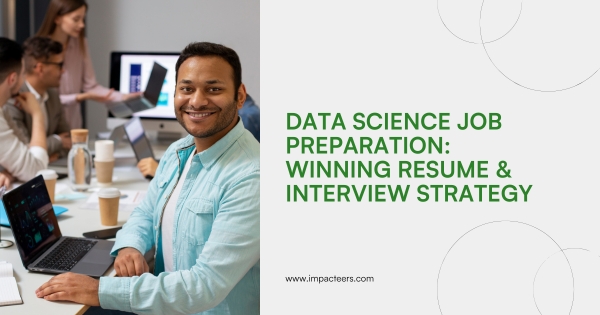Data Scientist Resume is your ticket to showcasing advanced analytics, machine learning expertise, and impactful project outcomes.
Data science sits at the core of today’s industries. Businesses across healthcare and e-commerce use data insights to decide their actions. This is why jobs in data science attract thousands of applicants.
But the challenge here is: Recruitors receive countless applications for every role. Many resumes look the same. If your data scientist does not start again, it does not pay attention in seconds, it is lost in the pile.
Good news? Along with the right strategy – clear resume writing, smart project highlights and solid interviews – you can stand out. Let’s dive
Visit Us >>> https://www.impacteers.com/home
1) Why Your Resume Matters More Than Your Marks
Hiring managers don’t just look for degrees. They want proof of skills.
Your resume is the first filter. It tells them:
- What tools you know.
- How you’ve applied them.
- Whether you can deliver results.
For job seekers in data science, a sharp resume is non-negotiable.
2) Anatomy of a Strong Data Scientist Resume
What should your resume builder include? Here’s a simple breakdown:
- Headline: “Data Scientist | Python | Machine Learning | SQL.”
- Summary: 3–4 lines about your experience, focus areas, and impact.
- Skills: List of tools—Python, R, TensorFlow, Power BI, etc.
- Experience: Show achievements, not duties.
- Projects: GitHub links or Kaggle competitions.
- Certifications: Data science, cloud, or analytics programs.
3) Resume Writing That Gets Interviews
Recruiters love clarity. Use these tips:
- Write short, action-driven bullet points.
- Show numbers: “Improved model accuracy by 12%.”
- Keep formatting simple. No fancy fonts.
- Highlight recent training or certifications.
- Update LinkedIn to match your resume.
4) Common Mistakes in Data Scientist Resumes
Even talented IT professionals make these mistakes:
- Listing every tool they’ve ever touched.
- Copy-pasting job duties instead of showing results.
- Forgetting to include links to projects.
- Sending the same resume to all companies.
A generic resume feels lazy. Tailoring shows effort.
5) Table: Sections That Make Your Resume Stand Out
| Section | What to Include | Why It Matters |
| Headline | “Data Scientist | ML |
| Summary | 3–4 lines on skills + impact | Sets the tone for recruiters |
| Skills | Tools, languages, frameworks | Shows technical depth |
| Experience | Results-driven bullet points | Proves real-world application |
| Projects | GitHub links, Kaggle, real datasets | Demonstrates practical problem-solving |
| Certifications | Online courses, bootcamps, data science badges | Adds credibility |
6) Tailoring Your Resume for Different Jobs
Data science roles vary. Some focus on machine learning, others on analytics or engineering. Always:
- Study the job description.
- Adjust your resume writing to highlight relevant tools.
- Push matching projects higher on the list.
For example, if the role mentions NLP, move your chatbot project to the top.
7) Preparing for the Interview: Technical Round
Most job seekers think interviews are just coding tests. In reality, companies want both problem-solving and clarity. Expect:
- Case studies: “How would you reduce churn for a telecom firm?”
- Coding: SQL queries, Python functions.
- ML concepts: Bias-variance trade-off, overfitting, cross-validation.
Practice solving real business problems. It shows you think beyond code.
8) Sample Technical Questions and Answers
Q1: What’s the difference between supervised and unsupervised learning?
“Supervised uses labeled data, like predicting prices. Unsupervised finds patterns, like customer segmentation.”
Q2: How do you handle missing values in data?
“Options include imputation, dropping rows, or using algorithms that handle missing values, depending on the dataset.”
Q3: Explain overfitting.
“It’s when a model learns training data too well and fails to generalize. Regularization and cross-validation help prevent it.”
Simple, clear answers impress.
9) Behavioral Interviews: Soft Skills in Focus
Employers don’t just test coding. They want IT professionals who can explain results, collaborate, and adapt.
Q: Tell me about a time you failed.
Don’t hide mistakes. Show learning. Example: “I deployed a model without enough testing. It failed in production. I learned to always validate thoroughly before rollout.”
Q: Why this company?
Show research. Mention their products, culture, or projects.
10) The Role of Soft Skills in Careers
A brilliant developer who can’t explain results will struggle. That’s why communication and storytelling matter. You’ll often present to managers with no data background. Clarity = credibility.
11) The LinkedIn Advantage for Job Seekers
Your LinkedIn profile is as important as your resume. Many recruiters search there first.
Tips:
- Add “Data Scientist Resume Available” in your headline.
- Post insights from your projects.
- Engage with data science discussions.
One recruiter message can change careers.
12) Using Resume Builders Wisely
Tools like resume builders give structure. But don’t let them do all the work. Personalize every line. Add numbers, rewrite generic text, and ensure your projects shine.
13) Stories of Job Seekers Who Made It
- Ravi: Struggled with generic resumes. After tailoring, he landed 3 interviews in a week.
- Ananya: Highlighted her Kaggle competition wins on her developer resume. Got noticed by a startup.
- Farhan: Focused on LinkedIn posting. A hiring manager reached out directly.
Proof that small changes create big opportunities.

Conclusion: Your Strategy for Success
Breaking into data science careers is tough, but not impossible. A clear, results-driven data scientist resume, paired with confident interview answers, makes all the difference.
Remember:
- Tailor every resume.
- Showcase projects.
- Keep answers simple, structured, and honest.
- Use LinkedIn to boost visibility.
Job seekers who mix technical depth with communication skills rise faster. Because in today’s competitive world, it’s not just about being good with data—it’s about proving it on paper and in person.
About Us >>> https://blog.impacteers.com/
FAQs
1. What’s the most important part of a data scientist resume?
The project section. Recruiters love seeing real-world applications.
2. Should freshers add online courses and certifications?
Yes. Certifications prove dedication and learning, especially if you lack experience.
3. How long should a data science resume be?
One page if fresher, two pages max for experienced job seekers.
4. How can I prepare for behavioral interviews?
Use the STAR method (Situation, Task, Action, Result) to structure answers.5. Do resume builders work for data science resumes?
They’re a good start but always customize for each job.




Post Comment